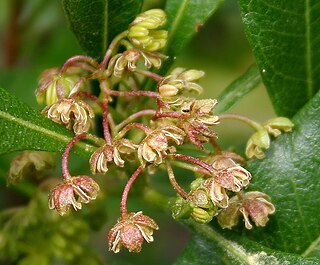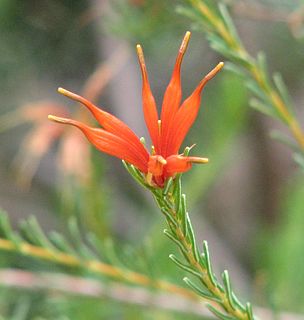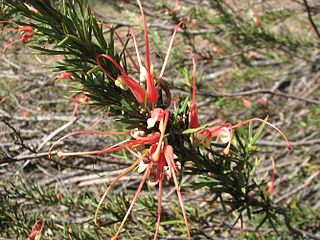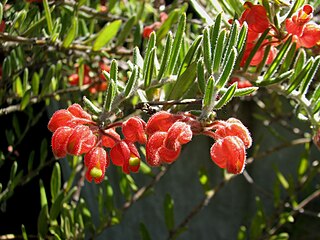
Dodonaea viscosa is a species of flowering plant in the soapberry family, Sapindaceae, that has a cosmopolitan distribution in tropical, subtropical and warm temperate regions of Africa, the Americas, southern Asia and Australasia.

Dodonaea is a genus of about 70 species of flowering plants, often known as hop-bushes, in the soapberry family, Sapindaceae. It has a cosmopolitan distribution in tropical, subtropical and warm temperate regions of Africa, the Americas, southern Asia and Australasia. By far the highest species diversity is in Australia. The genus is named after Rembert Dodoens, traditionally known as 'Dodonaeus'.

Lambertia ericifolia , commonly known as heath-leaved honeysuckle, is a shrub which is endemic to the south-west of Western Australia. It grow up to 5 metres high and has orange to red flowers which appear from spring to autumn.

Grevillea armigera, also known as prickly toothbrushes or thorny grevillea, is an erect shrub or tree which is endemic to the south-west of Western Australia. The species was formally described by Swiss botanist Carl Meissner in 1856.

Grevillea wilsonii, also known as Wilson's grevillea or native fuchsia, is a shrub endemic to the southwest of Western Australia. It usually grows to 1.5 metres in height and width, and produces brilliant red flowers, which later blacken, between July and December in its native range.

Grevillea involucrata, also known as Lake Varley grevillea, is a low-growing shrub which is endemic to the south-west of Western Australia. It grows up to 0.5 metres in height and produces pink flowers between June and October in its native range.

Grevillea asparagoides is a shrub which is endemic to the south-west of Western Australia. It grows up from 0.5 to 2 metres in height and produces bright red flowers between July and December in its native range.

Grevillea manglesii is a shrub which is endemic to an area around Perth in Western Australia. It usually grows to around 3 metres in height and 4 metres in width and produces white flowers throughout the year.

Grevillea endlicheriana, also known as spindly grevillea, is a shrub which is endemic to the southwest of Western Australia.

Grevillea montis-cole is a shrub which is endemic to central-western Victoria, Australia. It has similarities in appearance to Grevillea microstegia, Grevillea floripendula and Grevillea aquifolium but has larger floral bracts. The flowers, which appear between October and March in its native range, have greenish to fawn perianths and red styles.
Grevillea acacioides, is a shrub which is endemic to Western Australia.
Grevillea adenotricha is a shrub which is endemic to the north of Western Australia.

Grevillea tripartita is a shrub in the family Proteaceae. It is endemic to Western Australia, occurring in proximity to the south coast between the east of the Stirling Range and Point Culver.

Dodonaea microzyga, commonly known as brilliant hopbush, is a shrub in the family Sapindaceae. It grows to between 0.3 and 1.5 metres high.

Gymnostoma is a genus of about eighteen species of trees and shrubs, constituting one of the four genera of the plant family Casuarinaceae. The species grow naturally in the tropics, including at high altitudes having temperate climates, in forests in the region of the western Pacific ocean and Malesia. In New Caledonia, published botanical science describes eight species found growing naturally, which botanists have not found anywhere else (endemics). Additional species have been found across Burma, Sumatra, Borneo, the Philippines, Sulawesi, Ambon Island, the Moluccas, New Guinea, the Bismarck Archipelago, the Solomon Islands, and one endemic species each in Fiji and the Wet Tropics of Queensland, Australia.

Grevillea newbeyi is a shrub which is endemic to the south west region of Western Australia. It grows to between 0.5 and 1.5 metres in height. The pink to red and cream flowers usually appear from June to December in the species' native range. The species was first formally described by Donald McGillivray in 1986, his description published in New Names in Grevillea (Proteaceae).

Grevillea saccata, commonly known as pouched grevillea, is a shrub which is endemic to the south-west region of Western Australia. It grows to between 0.25 and 0.5 metres in height. The red flowers usually appear from June to November in the species' native range. The species was formally described in 1870 by English botanist George Bentham in his Flora Australiensis.

Grevillea asteriscosa, commonly known as star-leaf grevillea, is a shrub which is endemic to the south-west region of Western Australia. It grows to between 0.3 and 2.6 metres in height. The red flowers usually appear from July to November in the species' native range.
Dodonaea hispidula is a species of flowering plant in the hop-bush genus of the soapberry family. It is native to tropical northern Australia, where it occurs from the Kimberley region of north-western Western Australia, across the Top End of the Northern Territory, to northern Queensland. In Western Australia it is found in the Central Kimberley, Dampierland, Northern Kimberley, Ord Victoria Plain and Victoria Bonaparte IBRA bioregions.

Beyeria lechenaultii is a species of dioecious flowering plant in the spurge family, Euphorbiaceae, that is endemic to Australia.
















